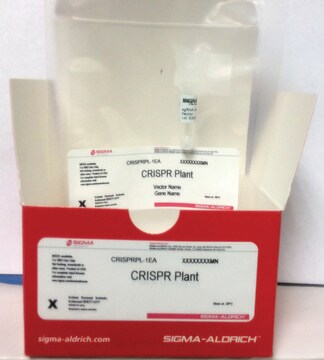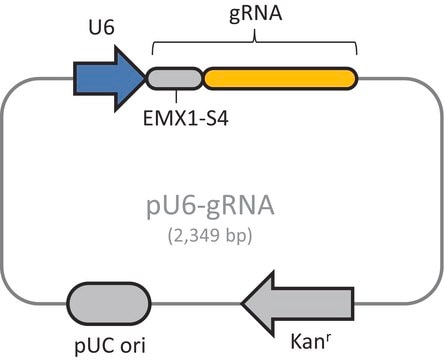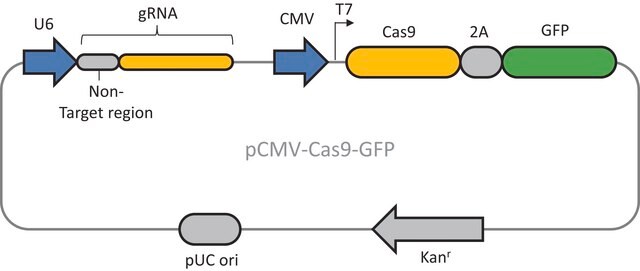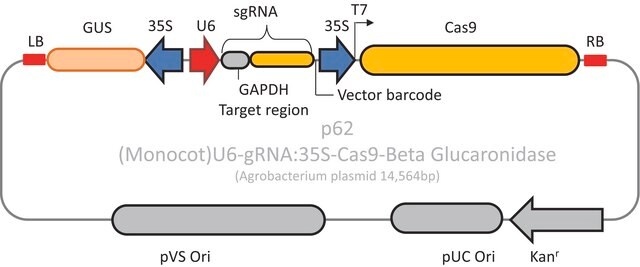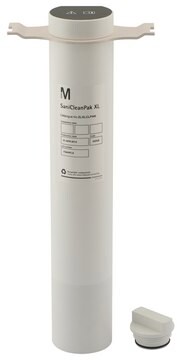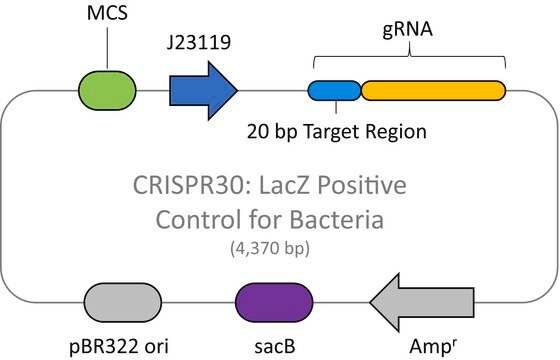CRISPRPL02
CRISPR GUS GAPDH Reporter Control for Dicots
Zaloguj sięWyświetlanie cen organizacyjnych i kontraktowych
About This Item
Kod UNSPSC:
12352200
NACRES:
NA.51
Polecane produkty
rekombinowane
expressed in E. coli
Poziom jakości
opakowanie
vial of 50 μL
stężenie
20 ng/μL in TE buffer; DNA (1μg of plasmid DNA)
Zastosowanie
CRISPR
selection
kanamycin
Warunki transportu
dry ice
temp. przechowywania
−20°C
Powiązane kategorie
Opis ogólny
All-in-one, ready-to-use Cas9 and guide RNA (gRNA) expression plasmids with GUS Reporter
CRISPR Plant Cas9 products are intended for Agrobacterium-mediated plant transformation. The products are based on the type IIA CRISPR-Cas9 derived from Streptococcus pyogenes. The native Cas9 coding sequence is codon optimized for expression in monocots and dicots, respectively. The monocot Cas9 constructs contain a monocot U6 promoter for sgRNA expression, and the dicot Cas9 constructs contain a dicot U6 promoter.
Arabidopsis seedlings were germinated in 6 well tissue culture plates
The seedlings were infected with Agrobacterium which had the CRISPR plasmids with a GUS reporter. After 3-4 days of transfection the GUS expression was detected. b-glucuronidase (GUS) is an enzyme that hydrolyzes colorless glucuronides to yield colored product
CRISPR Plant Cas9 products are intended for Agrobacterium-mediated plant transformation. The products are based on the type IIA CRISPR-Cas9 derived from Streptococcus pyogenes. The native Cas9 coding sequence is codon optimized for expression in monocots and dicots, respectively. The monocot Cas9 constructs contain a monocot U6 promoter for sgRNA expression, and the dicot Cas9 constructs contain a dicot U6 promoter.
Arabidopsis seedlings were germinated in 6 well tissue culture plates
The seedlings were infected with Agrobacterium which had the CRISPR plasmids with a GUS reporter. After 3-4 days of transfection the GUS expression was detected. b-glucuronidase (GUS) is an enzyme that hydrolyzes colorless glucuronides to yield colored product
Zastosowanie
- To verify successful integration of T-DNA in plant genome
- GUS receptor wheat gGAPDH control for monocots for Agrobacterium mediated transformation
Cechy i korzyści
- Low cost, genome editing option compared to other methods.
- Easy to use
- Online ordering
- Ready to ship in 2 days
Komponenty
1 vial containing 50ul of 20ng/ul plasmid DNA
Keep reagent tubes closed when not in use.
Practice aseptic lab technique to avoid DNase contamination.
Keep reagent tubes closed when not in use.
Practice aseptic lab technique to avoid DNase contamination.
Zasada
CRISPR/Cas systems are employed by bacteria and archaea as a defense against invading viruses and plasmids. Recently, the type II CRISPR/Cas system from the bacterium Streptococcus pyogenes has been engineered to function in eukaryotic systems using two molecular components: a single Cas9 protein and a non-coding guide RNA (gRNA). The Cas9 endonuclease can be programmed with a single gRNA, directing a DNA double-strand break (DSB) at a desired genomic location. Similar to DSBs induced by zinc finger nucleases (ZFNs), the cell then activates endogenous DNA repair processes, either non-homologous end joining (NHEJ) or homology-directed repair (HDR), to heal the targeted DSB.
Inne uwagi
For ordering any of our custom CRISPR plant products please visit: CUSTOM ORDERING FORM
Informacje prawne
This page may contain text that has been machine translated.
Kod klasy składowania
12 - Non Combustible Liquids
Klasa zagrożenia wodnego (WGK)
WGK 1
Temperatura zapłonu (°F)
Not applicable
Temperatura zapłonu (°C)
Not applicable
Certyfikaty analizy (CoA)
Poszukaj Certyfikaty analizy (CoA), wpisując numer partii/serii produktów. Numery serii i partii można znaleźć na etykiecie produktu po słowach „seria” lub „partia”.
Masz już ten produkt?
Dokumenty związane z niedawno zakupionymi produktami zostały zamieszczone w Bibliotece dokumentów.
Protokoły
ZFN i CRISPR/Cas9 rozwijają ukierunkowaną edycję genomu, otwierając nowe możliwości badawcze.
Nasz zespół naukowców ma doświadczenie we wszystkich obszarach badań, w tym w naukach przyrodniczych, materiałoznawstwie, syntezie chemicznej, chromatografii, analityce i wielu innych dziedzinach.
Skontaktuj się z zespołem ds. pomocy technicznej

